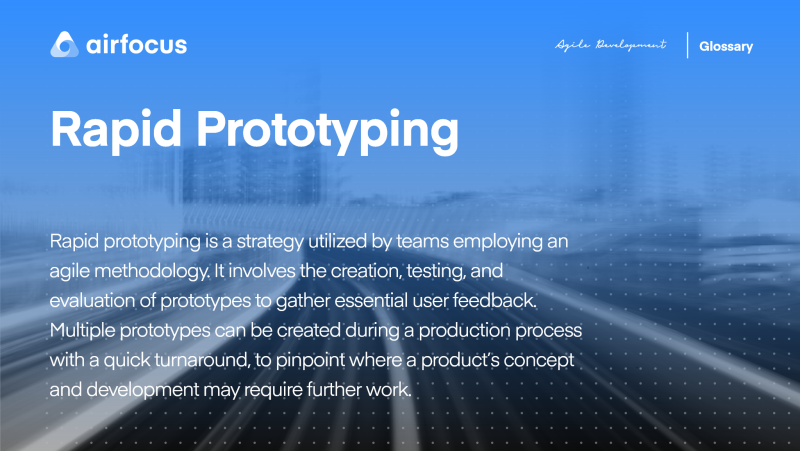Rapid Prototyping
What is Rapid Prototyping
Definition of Rapid Prototyping
Rapid prototyping is a strategy utilized by teams employing an agile methodology. It involves the creation, testing, and evaluation of prototypes to gather essential user feedback. Multiple prototypes can be created during a production process with a quick turnaround, to pinpoint where a product’s concept and development may require further work.
The name ‘rapid prototyping’ refers to the speed at which teams can gather feedback on new developments — everything from the creation of prototypes, to the user testing and subsequent reiteration based on feedback is done at a rapid pace.
This speed of testing and analysis stops teams from progressing too far with an idea or product which either fails to fit a consumer need or falls short of solving the problem it’s designed to answer.
Crucially, though, despite the speed at which rapid prototyping is rolled out, the prototypes that users interact with must feel like the real deal. If a consumer discovers they are providing feedback for anything other than the finished product, bias may creep in, rendering the feedback inaccurate.
Of course, the prototype will not have all the features of the finished product, but it must still be clickable and use-able, with realistic images, buttons and copy, etc.
The benefits of rapid prototyping
Rapid prototyping is an invaluable way to test how an idea or product is progressing. Conducting user research will help identify any potential issues or pitfalls in the user experience or functionality of a product before it’s too late.
Taking this insight, the team can then rework how the product looks and performs, to guarantee it solves the user’s need. In this way, rapid prototyping is a quick, cost-effective way to ensure that any new product or idea will be a success at launch.
What’s more, multiple prototypes may be created at the same time to conduct testing simultaneously, with different users (across varied demographics, for example) taking part. This allows teams to test slight differences in prototypes to learn more about user expectations and preferences.
Examples of rapid prototyping
While product designers may create wireframes and low-fidelity mock-ups in the development process, these shouldn’t be given to users as part of the rapid prototyping phase.
There’s a workable middle ground between a high-fidelity mock-up and a version of the product close to the final form.
Finding that spot can be tricky, but it all comes down to understanding exactly which features and elements are conducive to positive user experience.
Rapid prototyping still allows teams to create clickable versions of a product. In the case of software, for example, all the elements necessary for a functional UI and all related features must be present.
That’s why, despite being a popular prototyping technique, paper prototyping isn’t the optimal approach for digital solutions.
When using paper prototyping — i.e. using paper mock-ups, with hand-drawn or computer-generated ‘screens’ — the user quite clearly understands they are responding to an unfinished item. In this instance, the feedback they provide may be less useful than if they were engaged with something that feels like the end product.
For best results, rapid prototyping tools such as Sketch and InVision, where realistic wireframes can be created, should be used.
When do you need rapid prototyping?
Rapid prototyping provides product teams with hands-on user feedback which helps them recognize what further work is required ahead of launch. Putting problems right after a product hits the market can be more expensive and significantly damage a company’s reputation.
Businesses can — and should — implement rapid prototyping to learn more about any product they’re working on, gather insight on the target audience, and help spot opportunities for future developments.

General FAQ

Glossary categories
Create effective product strategy

Experience the new way of doing product management








